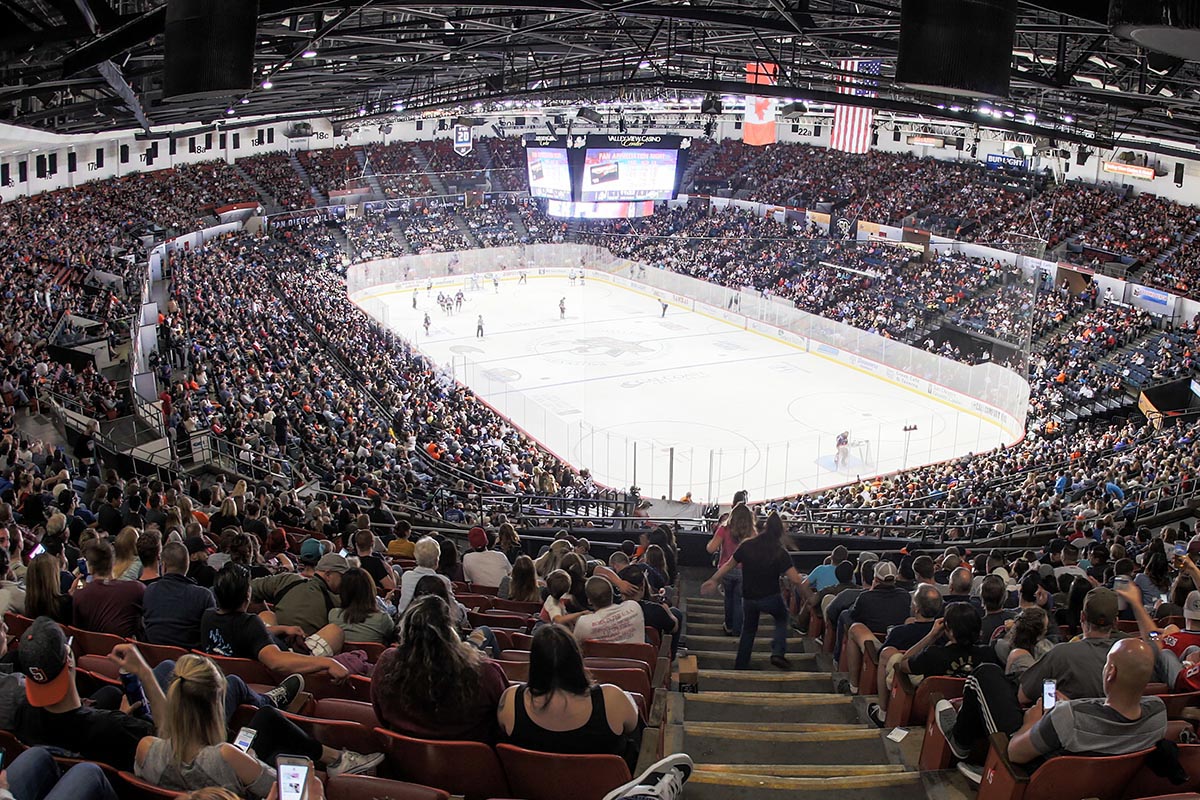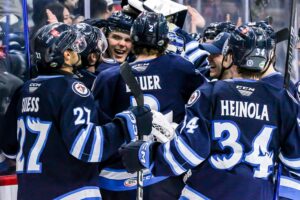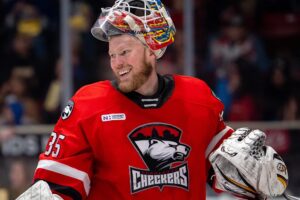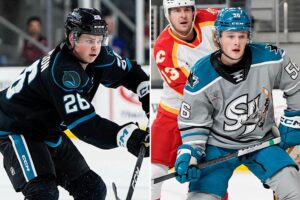by Craig Elsten | AHL On The Beat
From the rush of a raucous opening night in October to the thrill of the Calder Cup Playoffs beginning in mid-April, it’s amazing to think that the 2016-17 American Hockey League season has gone by so quickly.
For the second straight season, the San Diego Gulls do not have to stop after 68 games and will battle for the Calder Cup as the second seed in the Pacific Division.
A look back through the year that was reveals great development both on and off the ice.
On the ice, the Gulls set new club marks for wins, points and goals, in addition to having one of the best defensive records in the AHL. Of the 50 different players to have made an appearance with the Gulls this season — tied for the most total players used on a team in this season — 18 also played for the Anaheim Ducks in the National Hockey League. Through all of the roster churn, Gulls head coach Dallas Eakins has kept his team focused on its values and its goals.
“Our job is to develop players and to win,” said Eakins. “We’re all about habits. We’re all about work. And we’re all about detail.”
As young players develop in the AHL, many graduate to the NHL. This season began with Brandon Montour on the blue line along with Shea Theodore in San Diego; the young defensive pair started Game One of the Stanley Cup Playoffs for Anaheim. Forward Ondrej Kase opened the season as a top Gulls winger and he played over 50 games for the Ducks in the regular season and began the first round with Anaheim as well.
“All the guys that are up with the Ducks, I know they are invested not only in the Ducks, but if they are sent back they come with a smile on their face and they want to work hard,” Eakins noted.
The decision by Anaheim to relocate their AHL franchise from Norfolk, Va., to San Diego in 2015 has provided multiple benefits to the Ducks organization, according to Gulls general manager Bob Ferguson.
“One area I think it’s really helped is mentally for our players,” noted Ferguson. “When your team is in Virginia, you’re a whole continent away from your NHL club. In the players’ minds, they feel much closer to the league knowing it’s just a 90-minute car ride away.”
Ferguson added his pride in seeing San Diego players not only go up to Anaheim, but have success when they get there.
“We’re impressed with how the players who are going up are playing impact roles for the Ducks,” added Ferguson. “We’re happy with how we’re producing players, and with our coaching staff, when players move from here up they are prepared.”
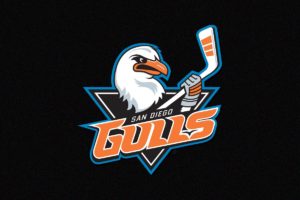 Going from year one to two for a new franchise comes with certain expectations, not all of them good. When Gulls president of business operations Matt Savant came to the club after 13 years with the Ducks front office, he was told to expect drops in attendance and revenue as the “new franchise smell” wears off and excitement wanes.
Going from year one to two for a new franchise comes with certain expectations, not all of them good. When Gulls president of business operations Matt Savant came to the club after 13 years with the Ducks front office, he was told to expect drops in attendance and revenue as the “new franchise smell” wears off and excitement wanes.
“I said I don’t agree with that, because I’ve lived here for years and I know this city,” said Savant. “I know these fans, and this is a passionate group that supports the Gulls.”
Savant went on to report that the Gulls will break not only their own AHL attendance record from last year, but the team’s revenue record as well.
“The goal is to continue to blur the lines between Anaheim and San Diego,” added Savant. “We try to get as many people in San Diego engaged with the Ducks as possible, and we want to get Ducks fans excited about what is happening with the Gulls. We’re starting to see the fan bases connect.”
After selling out the final regular-season game on Apr. 15, Gulls attendance for the 2016-17 season surpassed 300,000 — 6,000 more fans this year compared to 2015-16. On weekend home games this season, the Gulls averaged more than 10,000 fans through the gates. After Jan. 20, an average of 11,651 fans entered the turnstiles to take in Gulls hockey. Valley View Casino Center has become one of the toughest arenas to play in in the AHL, and the fan support is noted and appreciated by the players.
Nate Guenin, who has played in multiple AHL and NHL markets over the course of his hockey career, says all his expectations were exceeded here in San Diego.
“I’ve been absolutely blown away by the fan support we get,” said Guenin. “Every night, this building’s packed and it gets loud and the fans are into it. It makes it fun to come to the rink every night. You go anywhere around town and you see Gulls hats and shirts.”
While the Gulls took some lumps early, after the Christmas break the team built a club-record 12-game point streak from Jan. 7 to Feb. 7 (11-0-1-0) and never looked back. Guenin attributes the second-half success to the simplicity of talented players gaining experience.
“I think early in the year you saw a team with a lot of first-year guys coming together,” Guenin said. “Once everybody found their way, things really clicked. A lot of our go-to guys are first-year guys, and they just had to learn the professional game.”
This season, the team led by Eakins has continued last season’s success and parlayed it into the proverbial snowball as the team surpassed last year’s 39 wins and 84 points with a 43-20-3-2 record, good for 91 points. The Gulls finished the regular season with the third-highest points percentage in the AHL (.669).
Guenin credits Eakins with instilling a professional atmosphere built upon respect.
“I think a lot of coaches were former players, but when they become coaches they forget what it’s like to be a player,” Guenin observed. “Dallas remembers what it’s like to be a player. He knows when to rest us, when to put the pedal down, and when to heat things up.
“He’s as good a human being as he is a coach, and he treats everyone the right way. It makes it fun to play for him.”
By season’s end, the club is fortunate enough to continue to have a singular focus: winning the Calder Cup. Eakins knows, after two years living here with his family, the opportunity that presents itself to the Gulls to bring the city of San Diego a championship.
“Hey, this is my city now,” Eakins expressed. “I’ve been around. I’ve seen what’s going on. You feel a real commitment and a great challenge, one that I enjoy is ‘can I lead this team to win, ‘Can we win a championship?’”
“It wouldn’t be great for this community; it would be great for my community.”

































